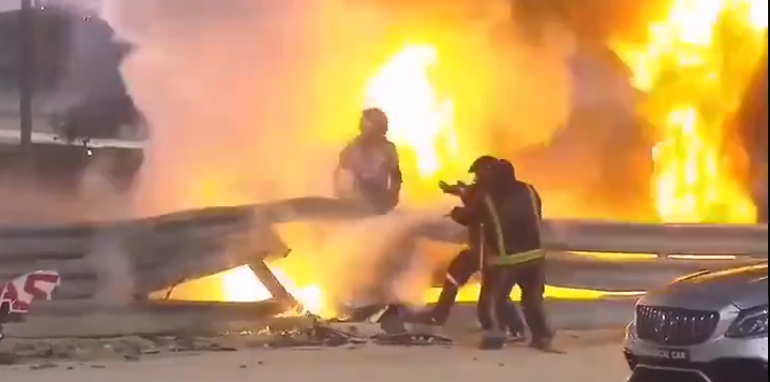Romain Grosjean came through a terrifying crash at the Bahrain Grand Prix on Sunday, as his Haas car smashed through a crash barrier and burst into flames.
Emerging with a marked face after 27 seconds in hell, Grosjean was checked for more serious damage beyond the burns, but, somehow, there was no more.
Grosjean hit 221 km/h and his car became engulfed by a fireball that had people fearing the worst, with television images cut due to protocol. Minutes later, though, it was reported that the French-Swiss driver was fine.
The car was split in two and fuel was left leaking in a way that shouldn’t happen. The Halo, though, was scratched but stayed whole.
“It was such a shocking image to see,” said Lewis Hamilton. “When I get in the car I know that I’m taking risks and I respect the dangers that are in this sport. I posted about it [on Twitter] while we were in that break because it’s horrifying.
“I don’t know what G forces he pulled, but I’m so grateful that the Halo worked. I’m grateful that the barrier didn’t slice his head up or something like that. It could have been so much worse.
“But it’s a reminder to us, and hopefully the people that are watching, that this is a dangerous sport and that is why we are out there pushing to the limit and playing with that limit, but you also have to respect it.”
As positive as it was that Grosjean was okay, Sebastian Vettel was left asking questions.
“It shouldn’t happen,” Vettel said. “The guardrail is there to deviate the car. I don’t know why it failed in that fashion and I don’t know why the car took fire straight away.
“It seems as if the guardrail was the cause. So I think there’s a lot of understanding to be done.”
Doctor Ian Roberts was quick on the scene to carry out the check on Grosjean.
“I think I told him to sit down,” Roberts said, remembering their arrival at the medical car.
“He was obviously very shaky and his visor was completely opaque, in fact melted. I managed to get his helmet off to check everything else was okay.
“It was going to be flames, smoke inhalation, airway issues and that nothing went up to his helmet, and we had a look at the helmet as well.
“But, looking at him clinically, we were quite happy with him from a life-threatening injury point of view, so it was about making him comfortable from the injuries we could see.
“He had some pain in his foot and hands, so from that point we knew it was safe enough to move him around into the car for protection and get some gel on to his burns, and then into the ambulance and to the medical centre.”

